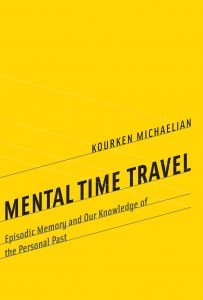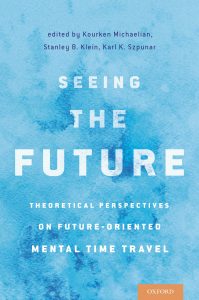There has been a great deal of research on episodic memory in animals. But debates over the uniqueness of human episodic memory continue. These debates can be understood as concerning two questions: When in evolution did episodic memory emerge? And why did it emerge?
 Both questions have both an empirical dimension, turning on issues in the assessment of the memory capacities of nonhuman animals, and a conceptual dimension, turning on our definition of episodic memory. Focusing on the conceptual dimension, in Mental Time Travel: Episodic Memory and Our Knowledge of the Personal Past I review existing explanations of the evolution of memory and argue for a new explanation in which the notion of process monitoring (introduced in my second post) figures centrally.
Both questions have both an empirical dimension, turning on issues in the assessment of the memory capacities of nonhuman animals, and a conceptual dimension, turning on our definition of episodic memory. Focusing on the conceptual dimension, in Mental Time Travel: Episodic Memory and Our Knowledge of the Personal Past I review existing explanations of the evolution of memory and argue for a new explanation in which the notion of process monitoring (introduced in my second post) figures centrally.
As I noted in my first post, understanding episodic memory as a form of mental time travel foregrounds the role played by autonoetic consciousness in remembering. But even if we grant that autonoesis plays an important role in remembering, it is not clear whether we ought to build a reference to it into our definition of episodic memory. Some researchers favour definitions of episodic memory as “episodic-like” or “what-when-where” memory. On these definitions, episodic memory is distinguished by the sort of information that it makes available, regardless of its phenomenology: information about the specifics of experienced past events. Others favour definitions which emphasize phenomenology over information. On these definitions, episodic memory is distinguished by the sort of consciousness that accompanies it: autonoesis, or consciousness of the self in subjective time.
There is good evidence that some nonhuman species are capable of remembering the specifics of past events. Thus, if we adopt a definition of the former sort, it will likely turn out that episodic memory is not uniquely human. But autonoesis — which presupposes a sophisticated sense of self — appears to be found only in humans. Thus, if we adopt a definition of the latter sort, it will likely turn out that episodic is uniquely human. I argue that, while certain clinical cases suggest that autonoesis might not, strictly speaking, be essential to episodic memory, nevertheless it is such a central feature that we should treat it as marking a qualitative difference between human episodic memory and animal episodic-like memory — only in humans do we find a capacity for highly flexible simulation of past and future events.
If this is right, it tells us that episodic memory emerged only with humans. But it does not tell us why episodic memory emerged. I canvass a number of past-oriented, future-oriented, and social explanations of the emergence of conscious episodic memory, before turning to metacognitive explanations. Tulving and, more recently, Klein have argued that autonoesis may have emerged because it contributes to our subjective certainty that our apparent memories are genuine. Though they do not put it quite this way, the idea is that autonoesis plays a role as a source monitoring criterion: rather than having to consciously infer that an apparent memory representation is indeed about the past, autonoesis more or less automatically gives rise to a sense that the representation is about the past.
I argue that this explanation is on the right track but overestimates the capacity of autonoesis to give rise to a sense that an apparent memory is indeed about the past. Autonoesis is involved in forms of mental time travel other than episodic memory. When I imagine a future event, for example, my sense that the simulated event “belongs to me” may be no less strong than it is when I remember a past event. So it cannot directly give rise to a sense that an apparent memory is about the past.
But autonoesis may nevertheless play a role in the metacognitive monitoring of memory. In particular, it may play a role, along with other phenomenological, content-based, and formal criteria, in process monitoring, enabling the subject to determine whether he is remembering or, instead, engaged in another form of mental time travel. Once the simulational process has been classified as remembering, source monitoring kicks in to enable the subject to determine the origins of his memory. Only then may the subject conclude that the apparent memory represents an event that actually occurred.
 Or so I claim. My overall argument depends on the view that remembering the past is continuous with imagining the future, and, while psychology has provided a good deal of evidence for this view, there are philosophical arguments for the view that remembering and imagining are sharply discontinuous. The debate on the relationship between memory and imagination continues in our edited book, Seeing the Future: Theoretical Perspectives on Future-Oriented Mental Time Travel, forthcoming from OUP in July 2016.
Or so I claim. My overall argument depends on the view that remembering the past is continuous with imagining the future, and, while psychology has provided a good deal of evidence for this view, there are philosophical arguments for the view that remembering and imagining are sharply discontinuous. The debate on the relationship between memory and imagination continues in our edited book, Seeing the Future: Theoretical Perspectives on Future-Oriented Mental Time Travel, forthcoming from OUP in July 2016.

